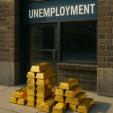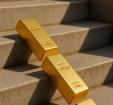Gold has a path to $4,000 as U.S. credibility crumbles
NEW YORK (May 12) Gold's safe-haven allure has rapidly faded after the U.S. and China announced a 90-day pause in their ongoing trade war. However, one market strategist expects the precious metal to maintain its luster as global financial markets continue to face significant geopolitical and economic uncertainty, even if trade disputes are eventually resolved.
In an interview with Kitco News, Nitesh Shah, Head of Commodities & Macroeconomic Research, Europe at WisdomTree, said that beyond global trade uncertainty, the next major risk he sees for the economy is U.S. monetary policy and the Federal Reserve’s independence.
Federal Reserve Chair Jerome Powell has received considerable criticism from President Donald Trump for his monetary policy stance. So far this year, the central bank has maintained a neutral policy and has been hesitant to cut interest rates, as inflation risks continue to rise amid relatively stable growth.
Last week, President Trump called Powell a “fool” after the central bank reiterated that it is not in any hurry to ease monetary policy. Despite the ongoing conflict, Trump has said he does not intend to fire Powell; however, Powell’s term ends in May 2026.
Shah said that gold could perform well if investors begin to question how independent the Fed will be as Trump starts looking for Powell’s replacement. He noted that markets could lose confidence in the Fed as the Trump administration continues to pressure the central bank to cut interest rates.
“If the Federal Reserve’s independence starts to be questioned, there is potential for its institutional strength to weaken,” he said. “Gold could see a significant rally, as it is the antithesis to a fiat currency that could be manipulated by a central bank. There is an increased need for hard assets like gold in this time of major geopolitical and monetary policy uncertainty.”
While gold continues to trade substantially below last month’s all-time highs of $3,500 an ounce, Shah said he expects it’s only a matter of time before gold finds renewed support and prices hit new records.
In his updated price forecast, Shah’s models show a baseline projection of $3,610 in the first quarter of 2026. However, he added that with so much uncertainty in financial markets, the risks are skewed to the upside.
According to his bullish modeling, Shah sees gold prices reaching $4,000 an ounce by the first quarter of 2026.
“We certainly think that speculative demand for gold should remain high with rising risks of recession and inflation,” he wrote in his latest report. “It took 14 years for gold to rise from $1,000/oz to $2,000/oz—and just over a year to go from $2,000/oz to $3,000/oz. It does not feel like a stretch of the imagination to see a further $1,000/oz added to today’s price, bringing it to over $4,000/oz.”
Along with Fed independence, Shah said the U.S. economy faces significant credibility issues. He noted that even if the global trade war is resolved, the U.S.’s reputation as a reliable trading partner has been tarnished.
In his latest report, Shah also outlined another significant bullish scenario in which the U.S. government attempts to implement what pundits have dubbed the “Mar-a-Lago Accord.” An economic paper published in November laid out a scenario where the U.S. dollar remains unchallenged as the world’s reserve currency—creating global economic stability while staying undervalued to support domestic manufacturing and the economy.
Shah noted that the last time the U.S. government weakened the dollar to reduce its trade deficit was in 1985, with the signing of the Plaza Accord. He pointed out that between 1985 and 1987, the U.S. dollar depreciated by 48%.
“In the Mar-a-Lago Accord, we model a 20% depreciation. Inflation would rise more than in our bull case. For this scenario, we remove an explicit bond yield assumption, as we believe yields could swing wildly in either direction. While the supposed intention of the policy move would be to reduce U.S. debt funding costs (and hence policymakers would like to see a decline in yields), refinancing debt would likely raise concerns about the U.S.’s reliability and potentially drive bond yields higher,” Shah said in his report. “Acknowledging these complications, we remove explicit assumptions on bond markets but assume gold will benefit from turbulence in the debt markets, as gold is a defensive alternative. We believe sentiment toward gold will strengthen substantially. As this scenario is far out of sample, we expect our forecast of $5,080/oz would be on the conservative side.”
While Shah continues to see upside potential for gold, he also acknowledges some downside risks. However, he added that in the current environment, any price weakness could be limited.
In his bear-case scenario, Shah sees gold prices falling to $2,700 an ounce.
“Just looking at my scenarios, more of them highlight upside risks to prices, and even the one scenario that goes down isn’t going down by that much,” he said. “Because there is so much uncertainty, I think investors are somewhat protected on the downside. Gold is going to be needed as a strategic asset.”
KitcoNews










